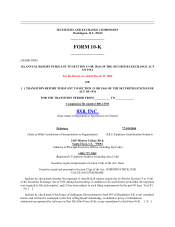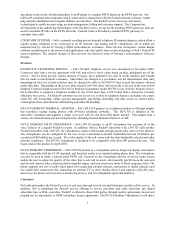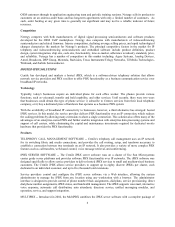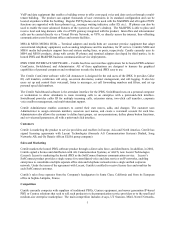8x8 2003 Annual Report Download - page 5
Download and view the complete annual report
Please find page 5 of the 2003 8x8 annual report below. You can navigate through the pages in the report by either clicking on the pages listed below, or by using the keyword search tool below to find specific information within the annual report.2
required at the customer site are telephones.
Available Information
The Company’s website address is http://www.8x8.com. The contents of this website are not incorporated in or
otherwise to be regarded as part of this annual report on Form 10-K. The Company files reports with the Securities
and Exchange Commission (SEC), which are available on 8x8’s website free of charge. These reports include
annual reports on Form 10-K, quarterly reports on Form 10-Q, current reports on Form 8-K and amendments to such
reports, each of which is provided on 8x8’s website as soon as reasonably practicable after the Company
electronically files such materials with or furnishes them to the SEC. You can also read and copy any materials we
file with the SEC at the SEC’s Public Reference Room at 450 Fifth Street, NW, Washington, DC 20549. You can
obtain additional information about the operation of the Public Reference Room by calling the SEC at 1-800-SEC-
0330. In addition, the SEC maintains a website (http://www.sec.gov) that contains reports, proxy and information
statements, and other information regarding issuers that file electronically with the SEC, including the Company.
INDUSTRY BACKGROUND
Traditional telecommunication networks use a fixed electrical path that travels through a series of switches across
the network. These networks were designed solely to carry low-fidelity audio signals with a high level of reliability.
Although these networks are indeed reliable for their initially intended use, these networks are not well suited to
service the explosive growth of digital communications applications.
Traditional networks transmit data at very low rates and resolutions, making them poorly suited for delivering high-
fidelity audio, entertainment-quality video or other rich multimedia content. Traditional networks are also expensive
to build because each subscriber's telephone must be individually connected to the central office switch, which is
usually several miles away from a typical subscriber's location. The digital component of the traditional
telecommunications infrastructure is also less efficient than modern networks because it allots fixed bandwidth
throughout the duration of each call, whether or not voice is actually being transmitted. Further, it is difficult for
telecommunication service providers to provide new or differentiated services or functions, like video
communications, that the network was not designed to accommodate.
In contrast to the traditional telecommunications infrastructure or public switched telephone network, or PSTN, data
networks -- such as the internet or a corporate LAN -- utilize a "packet-switched" system in which information
between two communicating terminals (for example, a PC downloading a page from a web server) is transmitted in
the form of small data packets that travel through a series of switches, routers, and hubs across the network. Packet-
switched networks have been built mainly for carrying non real-time data. The advantages of such networks are their
efficiency, flexibility, and scalability. Bandwidth is only consumed when needed. Networks can be built in a variety
of configurations to suit the number of users, client/server application requirements and desired availability of
bandwidth. Furthermore, many terminals can share the same connection to the network. The exponential growth of
the internet in recent years has proven the scalability of these underlying packet networks. The most common
protocol used for communicating on these packet networks is internet protocol, or IP.
As broadband connectivity has become more available and less expensive, it is now possible for service providers to
offer voice and video services that run over these IP networks to businesses and consumers. Providing such services
has the potential to both substantially lower the cost of telephone and equipment costs to these customers and to
increase the breadth of features available to the end-user. Services like full-motion, two-way video are now
supported by the bandwidth spectrum commonly available to broadband customers, whether business or residential.
To enable such new products, service and equipment suppliers need semiconductor products and software to connect
packet-based communication devices to the networks and the software that runs on the network that enables these
communication devices to be easily installed, operated, and managed, as well as to replace commonly used
functionality of the legacy switched network, such as billing and customer assistance.
PACKET8 AND CONSUMER SYSTEMS
Technology
8x8 has deployed an end-to-end voice and video communication service called Packet8. Packet8 is an internet-
based communication solution that works on virtually any ethernet network in the world, and allows calls to or from


















